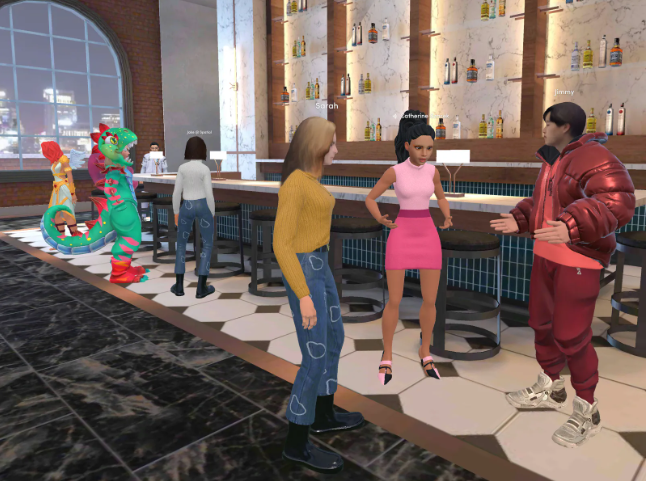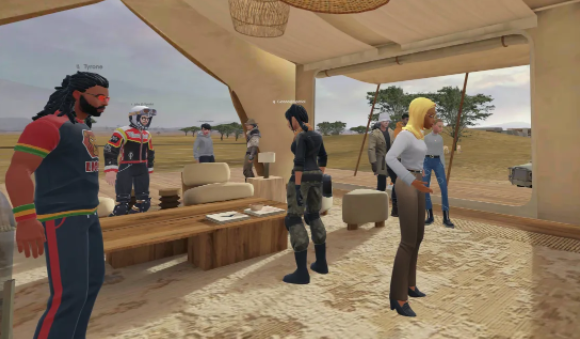Spatial VR Now Supports Full-Body Avatars
Virtual Reality workrooms app Spatial has added support for full-body avatars which provides greater realism in VR.
Being immersed in the computer-generated worlds of virtual reality often feels like some kind of astral projection. Not only are you groping in the dark with your headset on, floating hands, and with the risk of bumping onto objects (the Virtual Reality boundary system takes care of that) but you are also levitating in the virtual worlds without legs. The virtual version of you does not have any legs.

Spatial wants to change this by providing a full-body avatar option in the app. The New York-based virtual reality platform will also allow users to import avatars that have been created in Wolf3D’s Ready Player Me platform that leverages selfies to create realistic-looking and full-body cartoon avatars for games. At the moment, Ready Player Me provides approximately 300 customization options and Spatial wants to support all of them.
There are even Spatial avatars that can be sold as non-fungible tokens (NFTs) and these avatars will also be portable to other platforms including virtual reality, mobile apps, and desktops.
Spatial is a platform for hosting and selling virtual art so adding customizable full-body avatars, which are still an artistic form of expression, auger well with the company’s vision. Spatial says its audience is now more oriented toward a creator community that uses its app unlike two years ago and that the audience has been demanding more avenues for self-expression.
Spatial began its journey as a VR workplace collaboration app, consisting of virtual conferencing rooms, virtual happy hours, and shared PowerPoint presentations.

Spatial’s founders discovered that more of its users were using its virtual conference rooms to showcase artwork rather than to conduct business meetings or do corporate synergies. Additionally, most of Spatial’s users preferred to access the app via the web than inside a virtual reality headset. As a result, Spatial decided to pivot to support its burgeoning creator community. Now Spatial is focused on the vibrant world of NFTs and its prolific community of creators.
Legs on Avatars is a Great Addition to VR Experiences
We are already seeing a gradual rollout of full-body avatars in different virtual reality apps and this is some small progress towards creating greater realism in VR. After all, having virtual reality avatars moving about VR without legs magnifies the bizarreness of VR experiences and spoils the realism that we all aspire to. Metaverse worlds gotta be convincing experiences.
2021 saw Meta opening up the Horizon Worlds VR platform has been long under development. Horizon Worlds has been billed as a massive, multiplayer universe where you can interact with up to 20 friends simultaneously and that experience often entails interacting with legless avatars missing their lower halves. During a televised and cartoonized interview he had with Gayle King, Zuckerberg appeared as a half an avatar seated behind a table.
Many virtual reality platforms still don’t have full-body avatars. This is because it is technically difficult to implement the legs right in virtual reality. Rather than a virtual avatar that is moving synchronously or awkwardly and thereby ruins the user experience, many VR services prefer to have virtual avatar bodies that won’t have any legs. Having an avatar that moves awkwardly may also be insensitive to people who actually have real-life challenges walking well.
Virtual reality generally features two types of body tracking. Outside-in tracking features two cameras that are aimed at users wearing sensors and all the data points are processed inside the virtual environment. In inside-out tracking, the headsets, whether AR or VR, outward-facing cameras are used in capturing the space that is in front of the device’s wearer. These are the cameras that will track a user’s hands and make them useful inside virtual reality.
However, most of the VR development still ignores the feet. It is not just about the technical issues to do with the implementation. Feet are not needed to control things and can therefore be considered superfluous in VR experiences. Users can also still enjoy awesome VR experiences with just approximated leg movements. It is also costly to build downward-facing cameras in current virtual reality and augmented reality hardware and, at the moment, it is simply not worth the cost. Another way to achieve foot tracking would be to attach external sensors throughout the body but this would also be too costly and would complicate the setup for VR experiences. According to Meta’s chief technology officer Andrew Bozworth, from a physics standpoint, full-body tracking is “super hard” and unworkable with the current headsets.
However, there are also software-based techniques that can be used to process leg movements and replicate these in computer graphics like inverse kinematics, a mathematical process that is also being used by Spatial in its current implementation of full-body VR avatars with legs. Inverse kinematics is based on mathematical equations which take into account the constraints of the general flexibility of the human body to compute the position of a virtual reality user’s legs. However, inverse kinematics is merely based on estimations of how a user’s legs might be moving and do provide a rendition of the actual leg movements.
In an email, Meta’s general manager for avatars and identity Aigerim Shorman detailed the specific scenarios that must be met before Meta can fully embrace full-body avatars. According to Shorman, Meta must factor in the IRL state versus VR. For instance, if a user stands in the physical body, their virtual avatar should also stand and not perform other movements. Additionally, the relative position of the people and other objects in the room should adjust accordingly relative to the user’s motion. Shorman says that such a system must also factor in the environment the user is moving in such as whether the virtual height is rendered accurately relative to the proportions of the legs and body.
As tech companies embrace the metaverse ever more deeply, they will have to carefully look at the issues of identity and representation in VR environments. Spatial, for instance, is using photorealistic avatars and not cartoonish or anthropomorphized beings. However, its new leggy avatars don’t exhibit complete realism. For instance, the avatars aren’t configurable to have just one leg or a prosthetic or to sit on a wheelchair. The avatars are all fully able-bodied and not representative of all that log into VR.
There are people who might be ok with that. There are people who would be ok with fun avatars that are not necessarily representative of their real identities. On the other side of the spectrum, there are people who want avatars that are recognizable extensions of themselves inside the virtual games or universes. If the metaverse is going to be an integral part of our future lives, designers of virtual worlds will have to seriously consider how we think about ourselves and the different ways in which we want to project our personas into the VR universes.
Source: Wired
https://virtualrealitytimes.com/2022/05/08/spatial-vr-now-supports-full-body-avatars/https://virtualrealitytimes.com/wp-content/uploads/2022/05/Spatial-Avatar-has-Legs-600x447.pnghttps://virtualrealitytimes.com/wp-content/uploads/2022/05/Spatial-Avatar-has-Legs-150x90.pngTechnologyVirtual Reality workrooms app Spatial has added support for full-body avatars which provides greater realism in VR. Being immersed in the computer-generated worlds of virtual reality often feels like some kind of astral projection. Not only are you groping in the dark with your headset on, floating hands, and with...Sam OchanjiSam Ochanji[email protected]EditorVirtual Reality Times - Metaverse & VR
